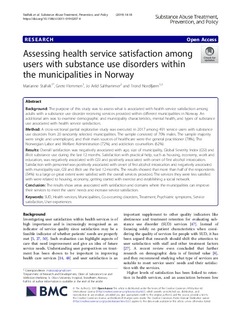| dc.contributor.author | Stallvik, Marianne | |
| dc.contributor.author | Flemmen, Grete | |
| dc.contributor.author | Salthammer, Jo Arild | |
| dc.contributor.author | Nordfjærn, Trond | |
| dc.date.accessioned | 2019-09-25T14:16:49Z | |
| dc.date.available | 2019-09-25T14:16:49Z | |
| dc.date.created | 2019-04-16T11:22:39Z | |
| dc.date.issued | 2019 | |
| dc.identifier.citation | Substance Abuse Treatment, Prevention, and Policy. 2019, 14 (1), 18-?. | nb_NO |
| dc.identifier.issn | 1747-597X | |
| dc.identifier.uri | http://hdl.handle.net/11250/2618811 | |
| dc.description.abstract | Background
The purpose of this study was to assess what is associated with health service satisfaction among adults with a substance use disorder receiving services provided within different municipalities in Norway. An additional aim was to examine demographic and municipality characteristics, mental health, and types of substance use associated with health service satisfaction.
Method
A cross-sectional partial explorative study was executed in 2017 among 491 service users with substance use disorders from 20 randomly selected municipalities. The sample consisted of 70% males. The sample majority were single and unemployed, and their main sources of healthcare were the general practitioner (78%), The Norwegian Labor and Welfare Administration (72%), and addiction counsellors (62%).
Results
Overall satisfaction was negatively associated with age, size of municipality, Global Severity Index (GSI) and illicit substance use during the last 12 months. Satisfaction with practical help, such as housing, economy, work and education, was negatively associated with GSI and positively associated with onset of first alcohol intoxication. Satisfaction with personnel was positively associated with onset of first alcohol intoxication and negatively associated with municipality size, GSI and illicit use the last 12 months. The results showed that more than half of the respondents (54%) to a large or great extent were satisfied with the overall services provided. The services they were less satisfied with were related to housing, economy, getting started with exercise and establishing a social network.
Conclusion
The results show areas associated with satisfaction and domains where the municipalities can improve their services to meet the users’ needs and increase service satisfaction. | nb_NO |
| dc.language.iso | eng | nb_NO |
| dc.publisher | BMC (part of Springer Nature) | nb_NO |
| dc.rights | Navngivelse 4.0 Internasjonal | * |
| dc.rights.uri | http://creativecommons.org/licenses/by/4.0/deed.no | * |
| dc.title | Assessing health service satisfaction among users with substance use disorders within the municipalities in Norway | nb_NO |
| dc.type | Journal article | nb_NO |
| dc.type | Peer reviewed | nb_NO |
| dc.description.version | publishedVersion | nb_NO |
| dc.source.pagenumber | 18-? | nb_NO |
| dc.source.volume | 14 | nb_NO |
| dc.source.journal | Substance Abuse Treatment, Prevention, and Policy | nb_NO |
| dc.source.issue | 1 | nb_NO |
| dc.identifier.doi | 10.1186/s13011-019-0207-4 | |
| dc.identifier.cristin | 1692869 | |
| dc.description.localcode | © The Author(s). 2019 Open Access This article is distributed under the terms of the Creative Commons Attribution 4.0 International License (http://creativecommons.org/licenses/by/4.0/) | nb_NO |
| cristin.unitcode | 1920,30,0,0 | |
| cristin.unitcode | 194,67,40,0 | |
| cristin.unitname | Klinikk for rus- og avhengighetsmedisin | |
| cristin.unitname | Institutt for psykologi | |
| cristin.ispublished | true | |
| cristin.fulltext | original | |
| cristin.qualitycode | 1 | |

